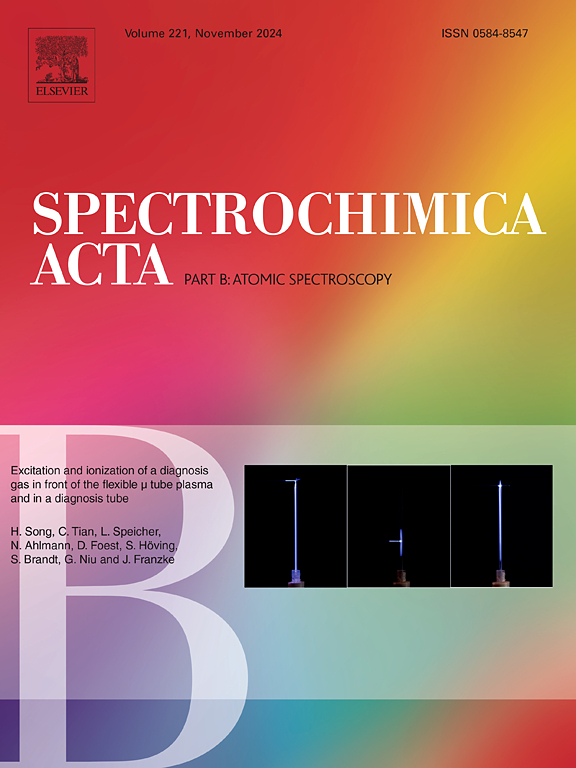Discrimination of single acrylic fibers focusing on zinc for forensic investigation using nanobeam synchrotron radiation X-ray fluorescence imaging and X-ray absorption fine structure analysis
IF 3.8
2区 化学
Q1 SPECTROSCOPY
引用次数: 0
Abstract
The identification of single acrylic fibers is critical in forensic science. Spinning solvents and dyes containing zinc are used to produce acrylic fibers. However, the information has not been used to identify acrylic single fibers for forensic purposes. This study aimed to discriminate between single acrylic fibers by focusing on zinc. A single type of red acrylic fiber from the Forensic Science Fiber Collection (Microtrace LLC, USA) was used as the standard sample. In contrast, nine commercially available colored acrylic fibers were used as samples. Owing to the limited beam time of synchrotron radiation X-ray analysis, total reflection X-ray fluorescence (TXRF) was used as a trace element screening method. Nanobeam synchrotron radiation X-ray fluorescence (SR-XRF) imaging of thinned acrylic single-fiber cross-sections was conducted to visualize the distribution of trace elements within a single fiber. X-ray absorption fine structure (XAFS) analysis was conducted to investigate the chemical states of zinc in the single acrylic fibers. The nanobeam SR-XRF imaging enabled the visualization of zinc derived from dyes and spinning solvents in single-fiber cross-sections. The images were classified into three distinct patterns. Two types of X-ray absorption near edge structure (XANES) spectra of the zinc absorption edge, reflecting the difference in the chemical state of zinc, were obtained from the acrylic single-fiber sample. In conclusion, the distribution and chemical state of zinc were found to be powerful indicators for distinguishing single acrylic fibers.

利用纳米束同步辐射x射线荧光成像和x射线吸收精细结构分析鉴别法医鉴定中聚焦锌的单腈纶纤维
单个丙烯酸纤维的鉴定在法医学中是至关重要的。用含锌的纺丝溶剂和染料生产腈纶。然而,这些信息还没有用于鉴定法医用途的丙烯酸单纤维。本研究旨在通过关注锌来区分单个丙烯酸纤维。我们使用来自Forensic Science fiber Collection (Microtrace LLC, USA)的一种红色腈纶作为标准样品。相比之下,九种市售的彩色丙烯酸纤维被用作样品。由于同步辐射x射线分析的束流时间有限,采用全反射x射线荧光(TXRF)作为痕量元素筛选方法。纳米束同步辐射x射线荧光(SR-XRF)成像薄丙烯酸单纤维的横截面可视化痕量元素在单纤维内的分布。采用x射线吸收精细结构(XAFS)分析研究了单根腈纶中锌的化学状态。纳米束SR-XRF成像能够在单纤维横截面上显示来自染料和纺丝溶剂的锌。这些图像被分为三种不同的模式。从丙烯酸单纤维样品中获得了锌吸收边缘的两类x射线吸收近边结构(XANES)光谱,反映了锌的化学状态的差异。综上所述,锌的分布和化学状态是区分单个腈纶纤维的有力指标。
本文章由计算机程序翻译,如有差异,请以英文原文为准。
求助全文
约1分钟内获得全文
求助全文
来源期刊
CiteScore
6.10
自引率
12.10%
发文量
173
审稿时长
81 days
期刊介绍:
Spectrochimica Acta Part B: Atomic Spectroscopy, is intended for the rapid publication of both original work and reviews in the following fields:
Atomic Emission (AES), Atomic Absorption (AAS) and Atomic Fluorescence (AFS) spectroscopy;
Mass Spectrometry (MS) for inorganic analysis covering Spark Source (SS-MS), Inductively Coupled Plasma (ICP-MS), Glow Discharge (GD-MS), and Secondary Ion Mass Spectrometry (SIMS).
Laser induced atomic spectroscopy for inorganic analysis, including non-linear optical laser spectroscopy, covering Laser Enhanced Ionization (LEI), Laser Induced Fluorescence (LIF), Resonance Ionization Spectroscopy (RIS) and Resonance Ionization Mass Spectrometry (RIMS); Laser Induced Breakdown Spectroscopy (LIBS); Cavity Ringdown Spectroscopy (CRDS), Laser Ablation Inductively Coupled Plasma Atomic Emission Spectroscopy (LA-ICP-AES) and Laser Ablation Inductively Coupled Plasma Mass Spectrometry (LA-ICP-MS).
X-ray spectrometry, X-ray Optics and Microanalysis, including X-ray fluorescence spectrometry (XRF) and related techniques, in particular Total-reflection X-ray Fluorescence Spectrometry (TXRF), and Synchrotron Radiation-excited Total reflection XRF (SR-TXRF).
Manuscripts dealing with (i) fundamentals, (ii) methodology development, (iii)instrumentation, and (iv) applications, can be submitted for publication.

 求助内容:
求助内容: 应助结果提醒方式:
应助结果提醒方式:


